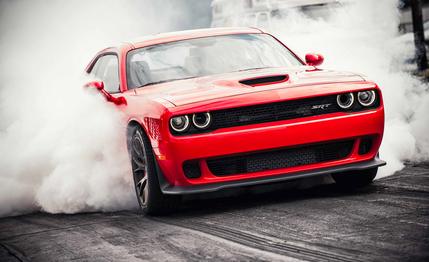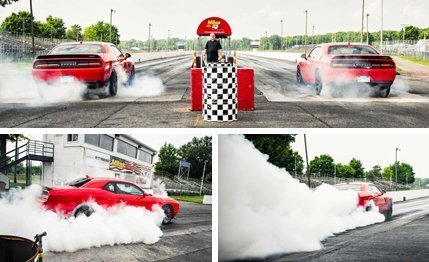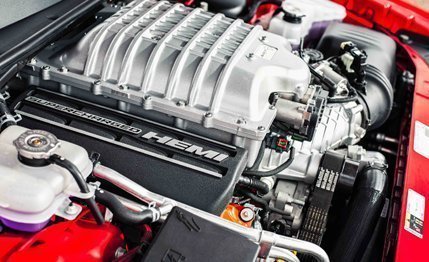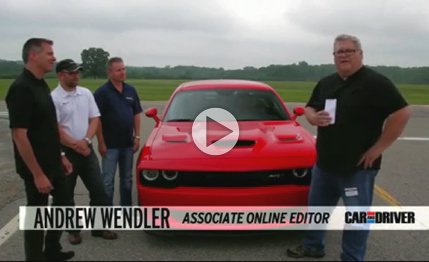
 First Drive Review
First Drive Review
Make room, Beelzebub, there’s a new demon-prince pony car in town, and it’s from the people who once brought you a real Demon. This Challenger brandishes numbers to shame the mightiest Mustangs and Camaros. Known in this mortal realm as the Dodge Challenger SRT Hellcat, its 6.2-liter supercharged Hemi V-8 conjures up a tire- and soul-melting 707 horsepower and 650 pound-feet of panty-bunching torque, played to a tune composed entirely of flatted fifth notes.
The pony-car business is by nature a game of one-upmanship, so it was inevitable that someone would eventually top the 662-hp Ford Mustang GT500. We just didn’t expect the 700-hp threshold to be crossed so soon. The Hellcat brings 45 more horsepower than the last Mustang GT500, 127 more than the Camaro ZL1, and, in what could be viewed as an act of internecine warfare, 67 more horsepower than the Viper’s V-10.

 Get thine Hellcat to a strip of blackest concrete and unleash the terrors of its 707-hp V-8 amid plumes of smoke.
Get thine Hellcat to a strip of blackest concrete and unleash the terrors of its 707-hp V-8 amid plumes of smoke.
To achieve such lofty output, Dodge started at the bottom, mounting a forged steel crankshaft with induction-hardened rod and main journals and a specially tuned damper. Forged connecting rods with upgraded bushings and carbon-coated wrist pins support forged alloy pistons. The aluminum cylinder heads are heat-treated, making them not only more expensive but, according to Dodge, also more difficult to machine. The payoff is better thermal characteristics—a fancy way of saying they won’t melt if you decide to run 15 back-to-back quarter-miles in an hour on a hot summer day. We know this to be true because we tried it.
Boost comes from an IHI supercharger residing below an aluminum intake plenum that bears a slight resemblance to the legendary aftermarket “Rat Roaster” intakes of the 1970s—sans carburetors, of course. What used to be the driver’s-side inside headlamp is now an air intake, and dual air-to-liquid intercoolers keep down the induction temps. To ensure that the fuel, air, and spark play nicely together under the full boost pressure of 11.6 psi, the compression ratio drops to 9.5:1 from the 10.9:1 squish factor employed in its naturally aspirated, 6.4-liter counterpart. According to Chris Cowland, director of advanced and SRT powertrain engineering, more than 90 percent of the engine content is new for this application.


Two key fobs come with the Hellcat. The black one, the “valet” key, is the archenemy of fun. It restricts output, caps revs at 4000, locks out first gear (from the optional automatic transmission), and puts the ESC in full-on mode. It also disables the paddle shifters, launch control, and drive-mode functions, effectively reducing the ’cat to a hissing tabby.
Firing up with the red fob, however, grants full access to the underworld. Push the dash-mounted start button and the 6.2-liter V-8 barks like Cerberus, its deep exhaust accented by a subtle whine from the supercharger. Combined, they produce a visceral and foreboding effect, the automotive equivalent of dropping the needle on a well-worn vinyl copy of The Stooges’ Fun House. Cowland tells us there was prolonged internal debate over how loud to let the blower wail. The quiet vote lost.


Pulling onto the 4.7-mile oval at Chrysler’s Chelsea proving grounds, the exhaust takes a solo, its pitch rising with engine rpm. The volume, however, is predicated not only on rpm, but also the valves plumbed into each leg of the dual exhaust tubes, nearly three inches in diameter. The electrically actuated valves are tuned to operate in concert with the engine calibration, ultimately arriving at the fully open, fully fortissimo position.